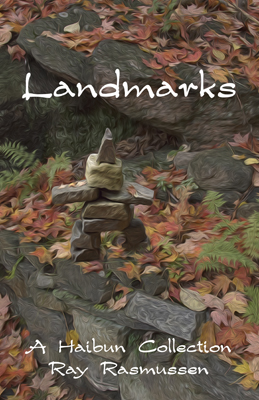A Review of Ray Rasmussen's Landmarks: A Haibun Collection
Adelaide B. Shaw
Ray Rasmussen, Landmarks: A Haibun Collection, Paperback, $8.50 USD & Kindle $4.49 USD, 112 pages, 63 haibun, 2 articles, Haibun Bookshelf Publishing, Edmonton, Canada, 2015, English Language, 6 x 9 inches, ISBN-13: 978-0994813800. Available on Amazon.com
 Landmarks, a collection of 63 haibun by Ray Rasmussen, was 15 years in the making. They are very personal pieces, including family relations, love, travel, retirement, aging and philosophical musings. They are records of a memory of an event lasting a few minutes or several hours, usually of the author as the main character, but occasionally the memory is about another person. Landmarks, a collection of 63 haibun by Ray Rasmussen, was 15 years in the making. They are very personal pieces, including family relations, love, travel, retirement, aging and philosophical musings. They are records of a memory of an event lasting a few minutes or several hours, usually of the author as the main character, but occasionally the memory is about another person.
The haibun are not organized into like-related subjects or in chronological order, but, as the author writes, in a "random order in which I remembered or lived each experience." These experiences cover childhood and school and adult experiences, including several relating to his wilderness journeys.
The cover art is of an inukshuk, a stone cairn in human shape. The author, who lives in Canada, explains that these widespread inuksuit (the plural of inukshuk) are used by the people of the Arctic as landmarks to indicate a good place to hunt, to fish, to camp, or that it is a spirit site. Like the inuksuit, these haibun represent landmarks in Rasmussen's life.
After the haibun are articles, one on Rasmussen's conception of what makes a haibun and the other an interview by Jeffrey Woodward, editor of Haibun Today. In the first article, "Modern English Haibun," the author lists ten points to consider when writing haibun. These are offered not as "commandments," but as "food for thought." Whether or not haibun writers and readers agree with the list, the haibun in this collection follow the author's own suggestions.
In point number 5, Rasmussen describes two types of haibun:
Narrative haibun has prose that focuses heavily on description
with few if any poetic devices such as similes, metaphors, allusions,
alliteration or repetition.
Literary haibun prose tends to make more
use of poetic flourishes and thus it more closely resembles prose
poetry.
Rasmussen's haibun fall more into the narrative category. They tell a story, a story of the author's life. I suggest that the reader read this essay first before reading the haibun.
Many of the author's experiences include meditative thoughts, a question asked, an observation made. In all, the poet/author accepts these experiences as his life. These haibun are more than a description of a hike in the desert or a memory of his children. They provide, as Rasmussen's writes "food for thought."
He is aware of the past which can't be changed, "All that Remains;" conscious of the present, "The Muse;" and curious of the future, "Pathways."
The author's wilderness haibun give the reader a sense of being there. Rasmussen is at home in these wild, desert places once home to the Anasazi. These haibun show an admiration and respect for the ruins and awe and wonder at the landscape. He is someone who recognizes the benefits of slowing down to enjoy each individual experience, not to simply rack them up and cross them off a list. This is covered well in the haibun, "The Whole Works," in which a young hiker is rushing through all the known places, while the author is content to sit and meditate at a small non-descript branch of the main canyon. The haibun ends with: "alpenglow / the long shadow cast / by a pebble."
The author is honest in his haibun, admitting to troubling relationships as in "Monk's Journey," which ends with a haiku by Basho: "winter seclusion / sitting propped against / the same worn post." Another honest admission appears in "Caught Out" in which the author admits to exhaustion at the end of a hike rather than being uplifted and inspired. This ends with a haiku by Issa: "listen, all you fleas, / you can come on pilgrimage, okay, / but then, off you get!"
This collection is not without humor. The author shows a light touch in several haibun as in "Dear Birdwatcher," which ends with: "dark clouds– / the robin gulps down / my raspberries." Another with humor is "Chest Pains!" which ends with: "Viagra TV Ad– / twenty elderly men dance / in the street."
Rasmussen's haibun show a record of a life of harmony and discord, of joy and grief, of adventure and ordinary experiences. The haiku fit the prose either by providing an apt observation that echoes the mood of the experience or by providing a contrast, adding a detail not present in the prose or a hint of what's to come.
Landmarks will not disappoint.
|

